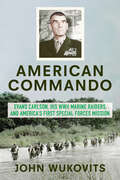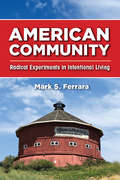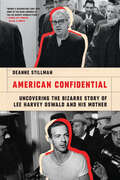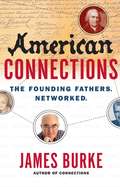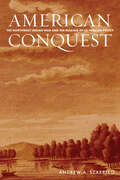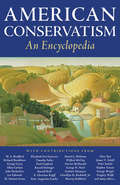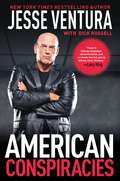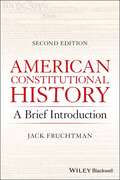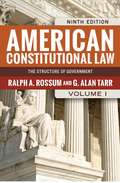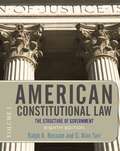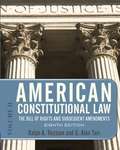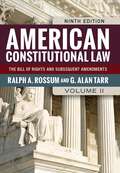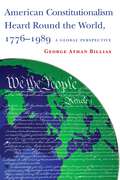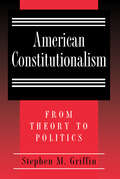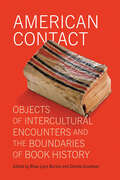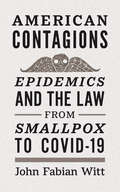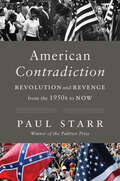- Table View
- List View
American Commando
by John WukovitsBefore the Green Berets. . . Before the Navy SEALs. . . Before the Army Rangers. . . There was the Long Patrol. November 1942: in the hellish combat zone of Guadalcanal, one man would make history. Lt. Col. Evans Carlson was considered a maverick by many of his comrades-and an outright traitor by others. He spent years observing guerrilla tactics all over the world, and knew that those tactics could be used effectively by the Marines. Carlson and an elite fighting force-the 2nd Raider Battalion-embarked upon a thirty-day mission behind enemy lines where they disrupted Japanese supplies, inflicted a string of defeats on the enemy in open combat, and gathered invaluable intelligence on Japanese operations on Guadalcanal. And in the process they laid the foundation for every branch of Special Forces in the modern military. Here, for the first time, is a riveting account of one man, one battalion, and one mission that would forever change the ways of warfare. .
American Community: Radical Experiments in Intentional Living
by Mark S. FerraraMainstream notions of the “American Dream” usually revolve around the ownership of private property, a house of one’s own. Yet for the past 400 years, a large number of Americans have dared to dream bigger and bolder, choosing to live in intentional communities that pooled resources, and they worked to ensure the well-being of all their members. American Community takes us inside forty of the most interesting intentional communities in the nation’s history, from the colonial era to the present day. You will learn about such little-known experiments in cooperative living as the Icarian communities, which took the utopian ideas expounded in a 1840 French novel and put them into practice, ultimately spreading to five states over fifty years. Plus, it covers more recent communities such as Arizona’s Arcosanti, designed by architect Paolo Soleri as a model for ecologically sustainable living. In this provocative and engaging book, Mark Ferrara guides readers through an array of intentional communities that boldly challenged capitalist economic arrangements in order to attain ideals of harmony, equality, and social justice. By shining a light on these forgotten histories, it shows that far from being foreign concepts, communitarianism and socialism have always been vital parts of the American experience.
American Confidential: Uncovering the Bizarre Story of Lee Harvey Oswald and his Mother
by Deanne Stillman"Deanne Stillman's American Confidential takes the familiar and makes it new - makes it thrilling. You won't believe this story; it resonates with deep American echoes." - Darin Strauss, author of Chang & Eng On the 60th anniversary of the JFK assassination, a critically acclaimed writer presents an astonishing new account of one of the 20th century's most notorious assassins, Lee Harvey Oswald—and the mother who raised him . . . Was Lee Harvey Oswald—as he himself claimed—a patsy? A hired gunman? In this startling account, Deanne Stillman suggests that there was indeed a conspiracy behind the assassination of John F. Kennedy—that of Oswald and his mother, Marguerite, who were locked in a desperate pursuit of fame and recognition. It was a struggle that would erupt on November 22, 1963, with Kennedy&’s murder—after which the assassin joined the roster of infamous immortals, while his mother spent the rest of her life seeking the media limelight. American Confidential is a mother-son noir tale that plays out across the Wild West of mid-twentieth century America, delving into Oswald&’s nomadic boyhood, and the world of his restless and disillusioned mother, who passed along a legacy of class resentment and a clamorous need to matter. In this new and surprising investigation into the short, troubled life of the ordinary man who would take down an American king, Deanne Stillman also presents a fascinating portrait of Oswald as a predecessor of the many violent young men and boys of America today, who take selfies with their rifles, and have come to define a new era of brutality. Following in the tradition of Joan Didion and Charles Bowden, and continuing her celebrated exploration of America&’s shadowlands, Stillman recounts a haunting tale of the promise and failure of the American dream. It held Oswald in its grip until the very end. &“Some day,&” he once told his wife, &“I&’d like to have a son. Maybe he&’ll grow up to be president.&”
American Congo: The African American Freedom Struggle in the Delta
by Nan Elizabeth WoodruffIn 1921, freedom fighter William Pickens described the Mississippi River Valley as the "American Congo. " Nan Woodruff argues that the African Congo under Belgium's King Leopold II is an apt metaphor for the Delta of the early twentieth century. Both wore the face of science, progressivism, and benevolence, yet were underwritten by brutal labor conditions, violence, and terror. As in the Congo, she argues, the Delta began with the promise of empire: U. S. capitalists on the lookout for new prospects cleared the vast Delta swamps. With the subsequent emergence of a wealthy planter class, the promise of untold riches, and a largely black labor force, America had its Congo. Woodruff chronicles the following half-century of individual and collective struggles as black sharecroppers fought to earn a just return for their labor, to live free from terror, to own property, to have equal access to the legal system, to move at will, and to vote. They fought for citizenship not only of men, but of women and families, and were empowered by the wars and upheavals of the time. Indeed, Woodruff argues, the civil rights movement cannot be adequately understood apart from these earlier battles for freedom.
American Connections: The Founding Fathers. Networked.
by James BurkeUsing the unique approach that he has employed in his previous books, author, columnist, and television commentator James Burke shows us our connections to the fifty-six men who signed the Declaration of Independence. Over the two hundred-plus years that separate us, these connections are often surprising and always fascinating. Burke turns the signers from historical icons into flesh-and-blood people: Some were shady financial manipulators, most were masterful political operators, a few were good human beings, and some were great men. The network that links them to us is also peopled by all sorts, from spies and assassins to lovers and adulterers, inventors and artists. The ties may be more direct for some of us than others, but we are all linked in some way to these founders of our nation. If you enjoyed Martin Sheen as the president on television's The West Wing, then you're connected to founder Josiah Bartlett. The connection from signer Bartlett to Sheen includes John Paul Jones; Judge William Cooper, father of James Fenimore; Sir Thomas Brisbane, governor of New South Wales; an incestuous astronomer; an itinerant math teacher; early inventors of television; and pioneering TV personality Bishop Fulton J. Sheen, the inspiration for Ramon Estevez's screen name, Martin Sheen.
American Conquest: The Northwest Indian War and the Making of US Foreign Policy
by Andrew A. SzarejkoThe first war of America's existence as an independent state was fought against the Shawnee, the Miami, and other Ohio River Valley tribes in the Northwest Indian War of 1790–95. The war provides a window into how US conquest of the continent would proceed through the next century and comprise a central element of US foreign policy into the future. Szarejko examines why the United States first engaged in this war to secure its claim to the Old Northwest and how the reverberations of the war extend far beyond the process of settlement. In focusing on US strategy during the war—its reliance on military bases to project power and a nascent counterinsurgency doctrine—Szarejko expertly traces the patterns established by this conflict throughout American political history and demonstrates how that military victory continues to be legitimized today through local commemorations of the war. This innovative book argues forcefully against the conventional claim that early US foreign policy was isolationist, brings Indigenous politics more fully into the realm of international relations, and allows researchers in several scholarly fields to better understand the nature of American conquest.
American Conservatism: An Encyclopedia (Radical Conservatisms Ser.)
by Bruce Frohnen Jeremy Beer Nelson O. Jeffrey&“A must-own title.&” —National Review OnlineAmerican Conservatism: An Encyclopedia is the first comprehensive reference volume to cover what is surely the most influential political and intellectual movement of the past half century. More than fifteen years in the making—and more than half a million words in length—this informative and entertaining encyclopedia contains substantive entries on those persons, events, organizations, and concepts of major importance to postwar American conservatism. Its contributors include iconic patriarchs of the conservative and libertarian movements, celebrated scholars, well-known authors, and influential movement activists and leaders.Ranging from &“abortion&” to &“Zoll, Donald Atwell,&” and written from viewpoints as various as those which have informed the postwar conservative movement itself, the encyclopedia&’s more than 600 entries will orient readers of all kinds to the people and ideas that have given shape to contemporary American conservatism. This long-awaited volume is not to be missed.
American Conservatism: NOMOS LVI (NOMOS - American Society for Political and Legal Philosophy #10)
by Melissa S. Williams Sanford V. Levinson Joel ParkerA collection of essays that unpacks the history, nature, development, and beliefs of American ConservatismThe topic of American conservatism is especially timely—and perhaps volatile. Is there what might be termed an “exceptional” form of conservatism that is characteristically American, in contrast to conservatisms found in other countries? Are views that are identified in the United States as conservative necessarily congruent with what political theorists might classify under that label? Or does much American conservatism almost necessarily reflect the distinctly liberal background of American political thought?In American Conservatism, a distinguished group of American political and legal scholars reflect on these crucial questions, unpacking the very nature and development of American conservative thought. They examine both the historical and contemporary realities of arguments offered by self-conscious conservatives in the United States, offering a well-rounded view of the state of this field. In addition to synoptic overviews of the various dimensions of American conservative thought, specific attention is paid to such topics as American constitutionalism, the role of religion and religious institutions, and the particular impact of the late Leo Strauss on American thought and thinkers. Just as American conservatism includes a wide, and sometimes conflicting, group of thinkers, the essays in this volume themselves reflect differing and sometimes controversial assessments of the theorists under discussion.
American Conspiracies and Cover-ups: JFK, 9/11, the Fed, Rigged Elections, Suppressed Cancer Cures, and the Greatest Conspiracies of Our Time
by Douglas CirignanoInterviews with Jim Marrs, Noam Chomsky, G. Edward Griffin, and Other Experts “Those intrepid souls seeking to peer deeper into America’s greatest conspiracies should start with Douglas Cirignano’s voluminous book. Pick your favorite conspiracy—Cirignano has them all, with incisive interviews with knowledgeable experts. Don’t miss this tour de force of conspiracy facts." —Jim Marrs, journalist and New York Times bestselling author of Rule by Secrecy; The Rise of the Fourth Reich; The Trillion-Dollar Conspiracy; and Population Control: How Corporate Owners Are Killing Us. American Conspiracies and Cover-ups brings together interviews with the bestselling and brightest minds in the alternative history world to create the definitive guide to our country’s biggest secrets. Interviews include:Jim Marrs on the New World OrderNoam Chomsky on mainstream mediaThe JFK assassination with LBJ’s lawyerVeteran and author Robert B. Stinnet on Pearl HarborG. Edward Griffin on the Federal Reserve BankDr. William F. Pepper on MLK's assassinationProfessor David Ray Griffin on 9/11and more!Author Douglas Cirignano brings together the foremost experts in the field to answer these questions once and for all, and proves that mainstream histories don’t tell the real story.
American Conspiracies: Lies, Lies, and More Dirty Lies That the Government Tells Us
by Jesse Ventura Dick RussellIn this explosive account of wrongful acts and on-going cover-ups, Jesse Ventura takes a systematic look at the wide gap between what the American government knows and what it reveals to the American people. For too long, we the people have sat by and let politicians and bureaucrats from both parties obfuscate and lie. And according to this former Navy SEAL, former pro wrestler, and former Minnesota governor, the media is complicit in these acts of deception. For too long, the mainstream press has refused to consider alternate possibilities and to ask the tough questions. Here, Ventura looks closely at the theories that have been presented over the years and separates the fact from the fiction. In Ventura's eyes, the murder of Abraham Lincoln and the assassinations of the Kennedys and Martin Luther King, all need to be re-examined. Was Watergate presented honestly, or was the CIA involved? Did the Republican Party set out to purposefully steal two elections on behalf of George W. Bush? Has all the evidence been presented about the 9/11 attacks or is there another angle that the media is afraid to explore? And finally, is the collapse of today's financial order and the bailout plan by the Federal Reserve the widest-reaching conspiracy ever perpetrated? "If you're talking outspoken, unconventional, and no-holds-barred, you're talking Jesse Ventura," Larry King. "I wouldn't mind seeing Ventura run for president (or for senator, or dog-catcher, or whatever). In addition to talking conspiracy, he's likely to raise all sorts of other trouble. " Damon W. Root, Reason Magazine
American Constitutional History: A Brief Introduction
by Jack FruchtmanReveals how the Constitution has evolved over the past 235 years, featuring updated coverage of the 2020 presidential election and constitutional changes made by the Supreme Court up to June 2021 American Constitutional History: A Brief Introduction, Second Edition presents a concise and accessible history of the 235-year development of the Constitution since its ratification. The book is organized around five distinct periods in U.S. history—the New Republic, the Slave Republic, the Free-Market Republic, the Social Welfare Republic, and the Contemporary Republic—to demonstrate the evolution of the American republic and its founding document over time. With an engaging narrative approach, author Jack Fruchtman describes how constitutional changes have occurred through both formal amendments and informal decisions by the president, Congress, and the Supreme Court. Updated to cover the period from 2015 to 2021, the second edition examines the controversial presidential election of 2020 in which Donald Trump, despite losing the electoral and popular vote, claimed victory and espoused charges of widespread election fraud. New coverage of the addition of Neil Gorsuch, Brett Kavanaugh, and Amy Coney Barrett to the Supreme Court is complemented by discussion of important decisions made after 2015, including affirming same-sex marriage, a woman's right to abortion under certain circumstances, the right to own and carry a firearm, and the central place of religious liberty in American society. This book also: Highlights the Constitution's evolution through government regulation of the economy, individual and civil rights, and executive power Reflects the evolution of constitutional changes made by the Supreme Court up to June 2021 Discusses topics such as the ideological origins of the U.S Constitution, the Civil War and Reconstruction, the civil rights movement, and growth of executive power Includes chapter overviews, summaries, and descriptions of formal constitutional amendments ratified by the states American Constitutional History: A Brief Introduction, Second Edition is an excellent introductory textbook for upper-level undergraduate and graduate courses in American history and political science and a must-read for general readers seeking insights into the origins and evolution of the U.S. Constitution.
American Constitutional Law, Volume I
by Ralph A. Rossum G. Alan TarrThe study of the Constitution and constitutional law is of fundamental importance to understanding the principles, prospects, and problems of America. American Constitutional Law, Volume I provides a comprehensive account of the nation’s defining document, comparing how its provisions were originally understood by those who drafted and ratified it with contemporary constructions. The authors examine the constitutional thought of the founders, as well as interpretations of the Constitution by the Supreme Court, Congress, the President, lower federal courts, and state judiciaries to provide students with a sense of how the law has been interpreted over the years. Now fully updated, the ninth edition of this classic volume features several new cases including National Federation of Independent Business v. Sebelius, Arizona v. United States, and Caperton v. A. T. Massey Coal Company Visit westviewconlaw. com for instructor resources, including recently decided cases, material from prior editions, and a glossary.
American Constitutional Law, Volume I
by Ralph A. Rossum G. Alan TarrAmerican Constitutional Law provides a comprehensive account of the nation’s defining document. Based on the premise that the study of the Constitution and constitutional law is of fundamental importance to understanding the principles, prospects, and problems of America, this text puts current events in terms of what those who initially drafted and ratified the Constitution sought to accomplish. The authors examine the constitutional thought of the founders, as well as interpretations of the Constitution by the Supreme Court, Congress, the President, lower federal courts, and state judiciaries. Now fully updated, the eighth edition of this classic volume focuses on federal rights and powers and incorporates six new cases, including Boumediene v. Bush, Medellin v. Texas, Hein v. Freedom from Religion Foundation, and Plains Commerce Bank v. Long Family Land and Cattle Company. Also available in its eighth edition from authors Ralph A. Rossum and G. Alan Tarr: American Constitutional Law, Volume II: The Bill of Rights and Subsequent Amendments (Westview Press, ISBN 978-0-8133-4478-2).
American Constitutional Law, Volume I: The Structure of Government
by Ralph A. Rossum G. Alan TarrA comprehensive core textbook and casebook that emphasizes precedent setting cases and alternative constitutional positions for courses in constitutional law and civil liberties.
American Constitutional Law, Volume II
by Ralph A. Rossum G. Alan TarrEnhance your understanding of the nation ‚'s defining document with AMERICAN CONSTITUTIONAL LAW: THE BILL OF RIGHTS AND SUBSEQUENT AMENDMENTS, VOLUME II! With a focus on individuals ‚' rights and responsibilities, this political science text provides you with the information you need to understand the principles, prospects, and problems of America. Chapter and case introductions frame the development of the law and help you understand both the material and its context. Precedent-setting cases in areas such as privacy, criminal procedure, and abortion rights are included in the text and you can use the companion website to read additional cases of historical significance and current cases as they are decided.
American Constitutional Law, Volume II
by Ralph A. Rossum G. Alan TarrThe study of the Constitution and constitutional law is of fundamental importance to understanding the principles, prospects, and problems of America. American Constitutional Law, Volume II, provides a comprehensive account of the nation's defining document, comparing how its provisions were originally understood by those who drafted and ratified it with contemporary constructions. The authors examine the constitutional thought of the founders, as well as interpretations of the Constitution by the Supreme Court, Congress, the President, lower federal courts, and state judiciaries to provide students with a sense of how the law has been interpreted over the years. Now fully updated, the ninth edition of this classic volume features eleven new cases including Caperton v. A. T. Massey Coal Company, Citizens United v. Federal Election Commission, Perry v. Brown, Snyder v. Phelps, and Holder v. Humanitarian Law Project. Visit www.westviewconlaw.com for additional resources, including recently decided cases, material from prior editions, and a glossary.
American Constitutional Law, Volume II
by Ralph A. Rossum G. Alan TarrThe study of the Constitution and constitutional law is of fundamental importance to understanding the principles, prospects, and problems of America. American Constitutional Law, Volume II provides a comprehensive account of the nation’s defining document, comparing how its provisions were originally understood by those who drafted and ratified it with contemporary constructions. The authors examine the constitutional thought of the founders, as well as interpretations of the Constitution by the Supreme Court, Congress, the President, lower federal courts, and state judiciaries to provide students with a sense of how the law has been interpreted over the years. Now fully updated, the ninth edition of this classic volume features several new cases including Caperton v. A. T. Massey Coal Company, Citizens United v. Federal Election Commission, Perry v. Brown, Snyder v. Phelps, and Holder v. Humanitarian Law Project. Visit westviewconlaw. com for instructor resources, including recently decided cases, material from prior editions, and a glossary.
American Constitutional Law, Volume II
by Ralph A. Rossum G. Alan TarrAmerican Constitutional Law provides a comprehensive account of the nation’s defining document. Based on the premise that the study of the Constitution and constitutional law is of fundamental importance to understanding the principles, prospects, and problems of America, this text puts current events in terms of what those who initially drafted and ratified the Constitution sought to accomplish. The authors examine the constitutional thought of the founders, as well as interpretations of the Constitution by the Supreme Court, Congress, the President, lower federal courts, and state judiciaries. Now fully updated, the eighth edition of this classic volume focuses on individuals’ rights and responsibilities and incorporates nine new cases, including District of Columbia v. Heller, In re Marriage Cases, Kennedy v. Louisiana, and Parents Involved in Community Schools v. Seattle School District No. 1. Also available in its eighth edition from authors Ralph A. Rossum and G. Alan Tarr: American Constitutional Law, Volume I: The Structure of Government (Westview Press, ISBN 978-0-8133-4477-5).
American Constitutional Law: Volume 1, The Structure of Government
by Ralph A. Rossum G. Alan TarrAmerican Constitutional Law provides a comprehensive account of the nation's defining document. Based on the premise that the study of the Constitution and constitutional law is of fundamental importance to understanding the principles, prospects, and problems of America, this text puts current events in terms of what those who initially drafted and ratified the Constitution sought to accomplish. The authors examine the constitutional thought of the founders, as well as interpretations of the Constitution by the Supreme Court, Congress, the President, lower federal courts, and state judiciaries. Now fully updated, the eighth edition of this classic volume focuses on federal rights and powers and incorporates six new cases, including Boumediene v. Bush, Medellin v. Texas, Hein v. Freedom from Religion Foundation, and Plains Commerce Bank v. Long Family Land and Cattle Company.Also available in its eighth edition from authors Ralph A. Rossum and G. Alan Tarr: American Constitutional Law, Volume II: The Bill of Rights and Subsequent Amendments (Westview Press, ISBN 978-0-8133-4478-2).
American Constitutional Law: Volume 2, The Bill of Rights and Subsequent Amendments
by Ralph A. Rossum G. Alan TarrAmerican Constitutional Law provides a comprehensive account of the nation's defining document. Based on the premise that the study of the Constitution and constitutional law is of fundamental importance to understanding the principles, prospects, and problems of America, this text puts current events in terms of what those who initially drafted and ratified the Constitution sought to accomplish. The authors examine the constitutional thought of the founders, as well as interpretations of the Constitution by the Supreme Court, Congress, the President, lower federal courts, and state judiciaries. Now fully updated, the eighth edition of this classic volume focuses on individuals' rights and responsibilities and incorporates nine new cases, including District of Columbia v. Heller, In re Marriage Cases, Kennedy v. Louisiana, and Parents Involved in Community Schools v. Seattle School District No. 1.Also available in its eighth edition from authors Ralph A. Rossum and G. Alan Tarr: American Constitutional Law, Volume I: The Structure of Government (Westview Press, ISBN 978-0-8133-4477-5).
American Constitutionalism Heard Round the World, 1776-1989: A Global Perspective
by George Athan BilliasWinner of the 2010 Book Award from the New England Historical AssociationAmerican constitutionalism represents this country’s greatest gift to human freedom, yet its story remains largely untold. For over two hundred years, its ideals, ideas, and institutions influenced different peoples in different lands at different times. American constitutionalism and the revolutionary republican documents on which it is based affected countless countries by helping them develop their own constitutional democracies. Western constitutionalism—of which America was a part along with Britain and France—reached a major turning point in global history in 1989, when the forces of democracy exceeded the forces of autocracy for the first time.Historian George Athan Billias traces the spread of American constitutionalism—from Europe, Latin America, and the Caribbean region, to Asia and Africa—beginning chronologically with the American Revolution and the fateful "shot heard round the world" and ending with the conclusion of the Cold War in 1989. The American model contributed significantly by spearheading the drive to greater democracy throughout the Western world, and Billias’s landmark study tells a story that will change the way readers view the important role American constitutionalism played during this era.
American Constitutionalism: From Theory to Politics
by Stephen M. GriffinDespite the outpouring of works on constitutional theory in the past several decades, no general introduction to the field has been available. Stephen Griffin provides here an original contribution to American constitutional theory in the form of a short, lucid introduction to the subject for scholars and an informed lay audience. He surveys in an unpolemical way the theoretical issues raised by judicial practice in the United States over the past three centuries, particularly since the Warren Court, and locates both theory and practices that have inspired dispute among jurists and scholars in historical context. At the same time he advances an argument about the distinctive nature of our American constitutionalism, regarding it as an instance of the interpenetration of law and politics. American Constitutionalism is unique in considering the perspectives of both law and political science in relation to constitutional theory. Constitutional theories produced by legal scholars do not usually discuss state-centered theories of American politics, the importance of institutions, behaviorist research on judicial decision making, or questions of constitutional reform, but this book takes into account the political science literature on these and other topics. The work also devotes substantial attention to judicial review and its relationship to American democracy and theories of constitutional interpretation.
American Contact: Objects of Intercultural Encounters and the Boundaries of Book History (Material Texts)
by Rhae Lynn Barnes and Glenda GoodmanHow studying material texts can help us better understand the diversity of the Americas, past and presentA Hawai’ian quilt stitched with anti-imperial messages; a Jesuit report that captures the last words of a Wendat leader; an invitation to a ball, repurposed by enslaved people in colonial Antigua; a book of poetry printed in a Peruvian penitentiary. Countless material texts—legible artifacts—resulted from the diverse intercultural encounters that characterize the history of the Americas.American Contact explores the dynamics of intercultural encounters through the medium of material texts. The forty-eight short chapters present biographies about objects that range in size from four miles long to seven by ten centimeters; date from millennia in the past to the 2000s; and originate from South America, North America, the Caribbean, and other parts of the Atlantic and Pacific worlds. Each essay demonstrates how particular ways of reading can render the complex meanings of the objects legible—or explains why and how the meanings remain illegible.In its diversity and breadth, this volume shows how the field of book history can be more inclusive and expansive. Taken together, the essays shed new light on the material practices of communicating power and resistance, subjection and survivance, in contact zones of America.Contributors: Carlos Aguirre, Ahmed Idrissi Alami, Chadwick Allen, Rhae Lynn Barnes, Molly H. Bassett, Brian Bockelman, George Aaron Broadwell, Rachel Linnea Brown, Nancy Caronia, Raúl Coronado, Marlena Petra Cravens, Agnieszka Czeblakow, Lori Boornazian Diel, Elizabeth A. Dolan, Alejandra Dubcovsky, Cecily Duffie, Devin Fitzgerald, Glenda Goodman, Rachel B. Gross, David D. Hall, Sonia Hazard, Rachel B. Herrmann, Alex Hidalgo, Abimbola Cole Kai-Lewis, Alexandra Kaloyanides, Rachael Scarborough King, Danielle Knox, Bishop Lawton, Jessica C. Linker, Don James McLaughlin, John Henry Merritt, Gabriell Montgomery, Emily L. Moore, Isadora Moura Mota, Barbara E. Mundy, Santiago Muñoz Arbeláez, Marissa Nicosia, Diane Oliva, Megan E. O’Neil, Sergio Ospina Romero, John H. Pollack, Shari Rabin, Daniel Radus, Nathan Rees, Anne Ricculli, Maria Ryan, Maria Carolina Sintura, Cristina Soriano, Chelsea Stieber, Amy Kuʻuleialoha Stillman, Chris Suh, Mathew R. Swiatlowski, Marie Balsley Taylor, Martin A. Tsang, Germaine Warkentin, Adrian Chastain Weimer, Bethany Wiggin, Xine Yao, Corinna Zeltsman.
American Contagions: Epidemics and the Law from Smallpox to COVID-19
by John Fabian WittA concise history of how American law has shaped—and been shaped by—the experience of contagion“Contrarians and the civic-minded alike will find Witt’s legal survey a fascinating resource”—Kirkus, starred review “Professor Witt’s book is an original and thoughtful contribution to the interdisciplinary study of disease and American law. Although he covers the broad sweep of the American experience of epidemics from yellow fever to COVID-19, he is especially timely in his exploration of the legal background to the current disaster of the American response to the coronavirus. A thought-provoking, readable, and important work.”—Frank Snowden, author of Epidemics and Society From yellow fever to smallpox to polio to AIDS to COVID-19, epidemics have prompted Americans to make choices and answer questions about their basic values and their laws. In five concise chapters, historian John Fabian Witt traces the legal history of epidemics, showing how infectious disease has both shaped, and been shaped by, the law. Arguing that throughout American history legal approaches to public health have been liberal for some communities and authoritarian for others, Witt shows us how history’s answers to the major questions brought up by previous epidemics help shape our answers today: What is the relationship between individual liberty and the common good? What is the role of the federal government, and what is the role of the states? Will long-standing traditions of government and law give way to the social imperatives of an epidemic? Will we let the inequities of our mixed tradition continue?
American Contradiction: Revolution and Revenge from the 1950s to Now
by Paul StarrHow did Americans come to elect Barack Obama—and then Donald Trump? Those choices capture what Paul Starr calls the American contradiction. The whole truth about America, Starr argues in this new history of the United States since the 1950s, has never been contained in one consistent set of values or interests. The nation was born in the contradiction between freedom and slavery. Today it is beset by a contradiction between a changing people and a resisting nation, a nation with entrenched institutions that have empowered those who fear the changes and look to restore an old America of their imagining. Starr tells this history from the dual standpoints of the progressive movements that changed the American people and of the movements that emerged in response. Black Americans, he argues, served as a model minority, setting in motion America’s twentieth-century revolutions in gender as well as race and rights. With industry’s decline and the rise of economic inequality, millions of Americans have felt dispossessed and want the old America back. Trump is their revenge. American Contradiction tells the story of how 1950s America became the almost unrecognizable America of the 2020s.
